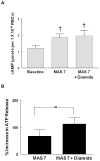Diamide decreases deformability of rabbit erythrocytes and attenuates low oxygen tension-induced ATP release
- PMID: 20682601
- PMCID: PMC3138790
- DOI: 10.1258/ebm.2010.010118
Diamide decreases deformability of rabbit erythrocytes and attenuates low oxygen tension-induced ATP release
Abstract
Exposure of erythrocytes to reduced oxygen (O(2)) tension activates the heterotrimeric G-protein Gi, resulting in the accumulation of cyclic AMP (cAMP) and release of ATP. The mechanism by which exposure of erythrocytes to reduced O(2) tension activates Gi is not known. Here we investigate the hypothesis that, in rabbit erythrocytes, ATP release in response to exposure to reduced O(2) tension is linked to erythrocyte membrane deformability. If this hypothesis is correct, then decreasing the deformability of the erythrocyte membrane should decrease the release of ATP in response to reduced O(2) tension. We report that treating erythrocytes with diamide, a compound that decreases erythrocyte deformability, inhibits low O(2) tension-induced ATP release. Treating erythrocytes with diamide does not, however, interfere with cAMP accumulation or ATP release in response to a direct activator of Gi (mastoparan 7) or in response to receptor-mediated activation of Gs (the prostacyclin analog, iloprost). These results demonstrate that diamide (100 micromol/L) does not directly inhibit the signaling pathways for ATP release from rabbit erythrocytes and support the hypothesis that low O(2) tension-induced ATP release from these cells is linked to membrane deformability.
Figures




Similar articles
-
The Rho kinase inhibitor Y-27632 increases erythrocyte deformability and low oxygen tension-induced ATP release.Am J Physiol Heart Circ Physiol. 2011 Nov;301(5):H1891-6. doi: 10.1152/ajpheart.00603.2011. Epub 2011 Sep 2. Am J Physiol Heart Circ Physiol. 2011. PMID: 21890695 Free PMC article.
-
NO inhibits signal transduction pathway for ATP release from erythrocytes via its action on heterotrimeric G protein Gi.Am J Physiol Heart Circ Physiol. 2004 Aug;287(2):H748-54. doi: 10.1152/ajpheart.00161.2004. Epub 2004 Apr 8. Am J Physiol Heart Circ Physiol. 2004. PMID: 15072952
-
Simvastatin and GGTI-2133, a geranylgeranyl transferase inhibitor, increase erythrocyte deformability but reduce low O(2) tension-induced ATP release.Am J Physiol Heart Circ Physiol. 2013 Mar 1;304(5):H660-6. doi: 10.1152/ajpheart.00635.2012. Epub 2013 Jan 18. Am J Physiol Heart Circ Physiol. 2013. PMID: 23335799 Free PMC article.
-
Regulation of cAMP by phosphodiesterases in erythrocytes.Pharmacol Rep. 2010 May-Jun;62(3):475-82. doi: 10.1016/s1734-1140(10)70303-0. Pharmacol Rep. 2010. PMID: 20631411 Free PMC article. Review.
-
Erythrocyte-derived ATP and perfusion distribution: role of intracellular and intercellular communication.Microcirculation. 2012 Jul;19(5):430-9. doi: 10.1111/j.1549-8719.2011.00158.x. Microcirculation. 2012. PMID: 22775760 Free PMC article. Review.
Cited by
-
Rho-kinase inhibition improves haemodynamic responses and circulating ATP during hypoxia and moderate intensity handgrip exercise in healthy older adults.J Physiol. 2022 Jul;600(14):3265-3285. doi: 10.1113/JP282730. Epub 2022 May 29. J Physiol. 2022. PMID: 35575293 Free PMC article. Clinical Trial.
-
Sepsis impairs microvascular autoregulation and delays capillary response within hypoxic capillaries.Crit Care. 2015 Nov 5;19:389. doi: 10.1186/s13054-015-1102-7. Crit Care. 2015. PMID: 26537126 Free PMC article.
-
Purinergic control of red blood cell metabolism: novel strategies to improve red cell storage quality.Blood Transfus. 2017 Oct;15(6):535-542. doi: 10.2450/2017.0366-16. Epub 2017 Apr 12. Blood Transfus. 2017. PMID: 28488967 Free PMC article. Review.
-
Kinetics of extracellular ATP in mastoparan 7-activated human erythrocytes.Biochim Biophys Acta. 2013 Oct;1830(10):4692-707. doi: 10.1016/j.bbagen.2013.05.033. Epub 2013 Jun 4. Biochim Biophys Acta. 2013. PMID: 23742824 Free PMC article.
-
Regulation of blood flow distribution in skeletal muscle: role of erythrocyte-released ATP.J Physiol. 2012 Oct 15;590(20):4985-91. doi: 10.1113/jphysiol.2012.233106. Epub 2012 May 14. J Physiol. 2012. PMID: 22586223 Free PMC article. Review.
References
-
- Bergfeld GR, Forrester T. Release of ATP from human erythrocytes in response to a brief period of hypoxia and hypercapnia. Cardiovasc Res. 1992;26:40–47. - PubMed
-
- Ellsworth ML. Red blood cell-derived ATP as a regulator of skeletal muscle perfusion. Med Sci Sports Exerc. 2004;36:35–41. - PubMed
-
- Ellsworth ML, Forrester T, Ellis CG, Dietrich HH. The erythrocyte as a regulator of vascular tone. Am J Physiol. 1995;269:H2155–2161. - PubMed
-
- Dietrich HH, Ellsworth ML, Sprague RS, Dacey RG., Jr Red blood cell regulation of microvascular tone through adenosine triphosphate. Am J Physiol Heart Circ Physiol. 2000;278:H1294–1298. - PubMed
Publication types
MeSH terms
Substances
Grants and funding
LinkOut - more resources
Full Text Sources

